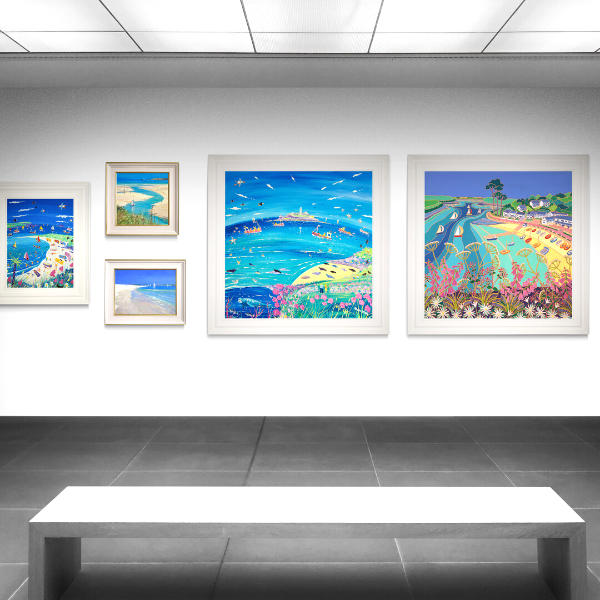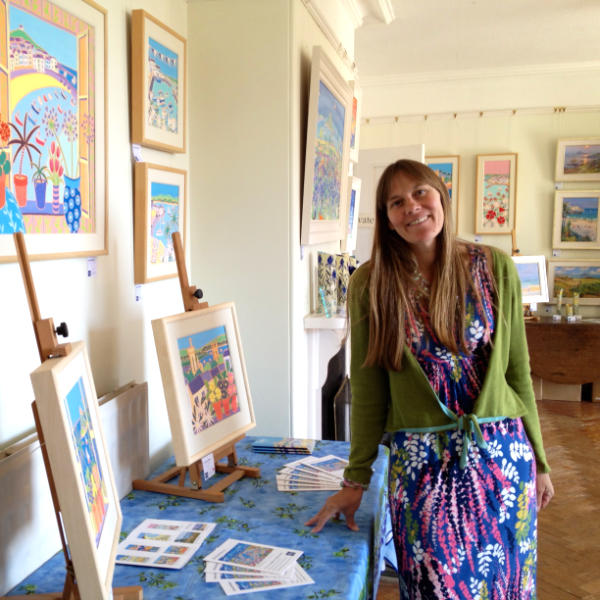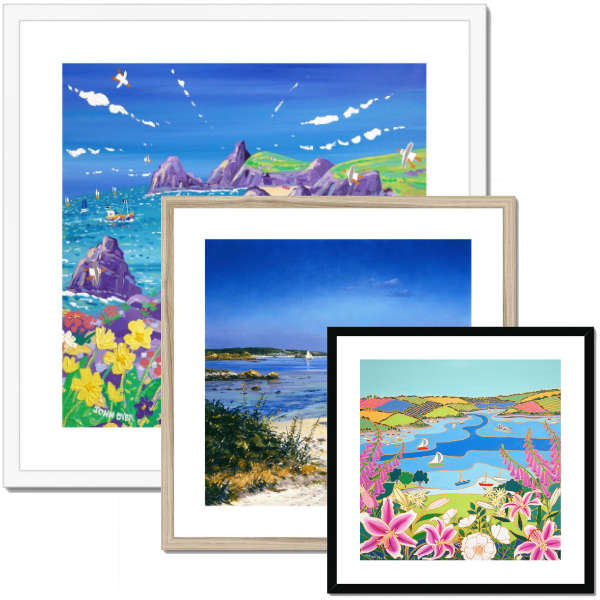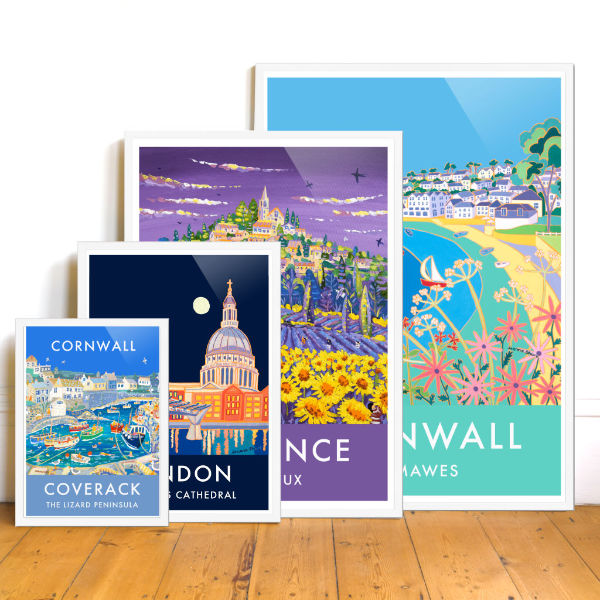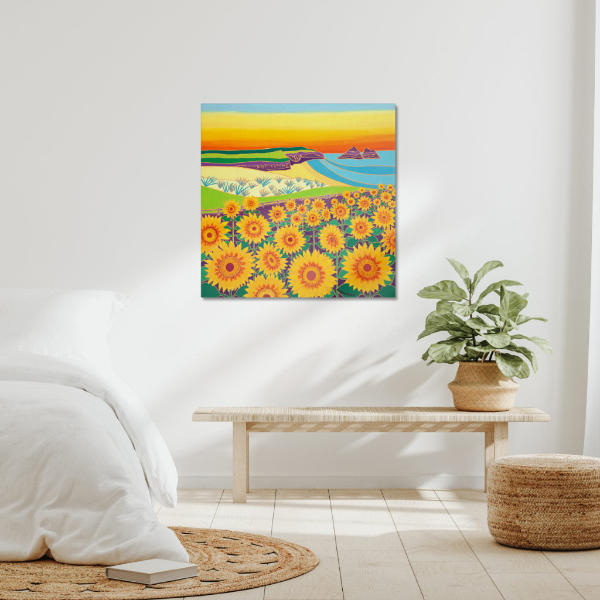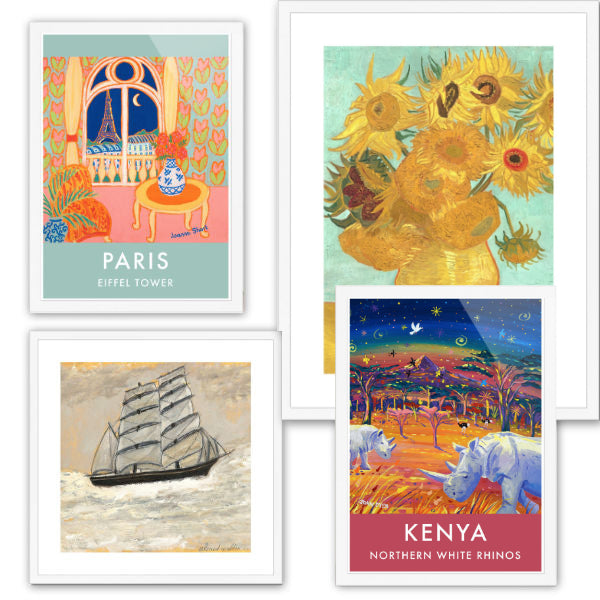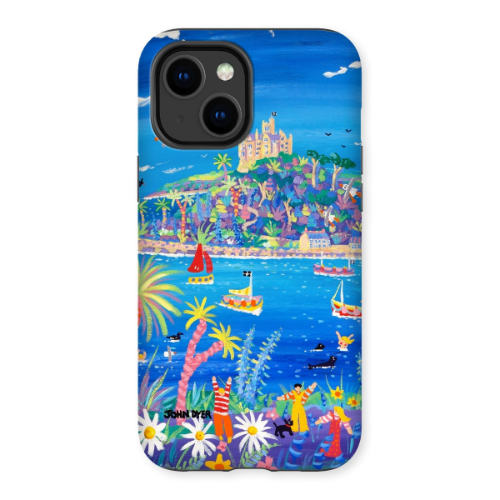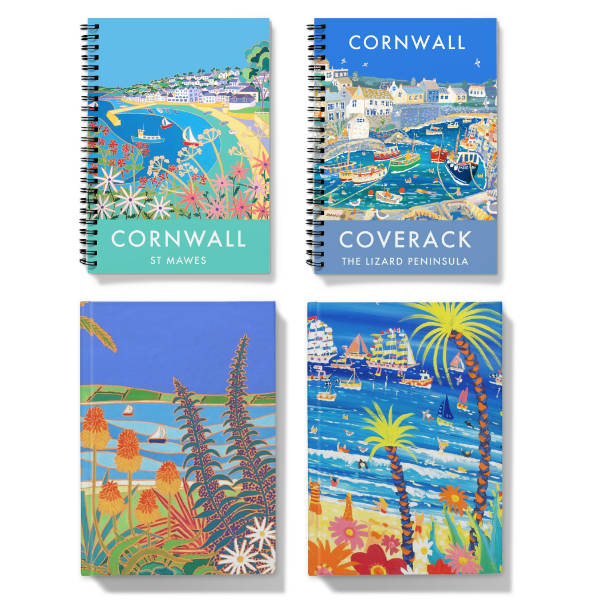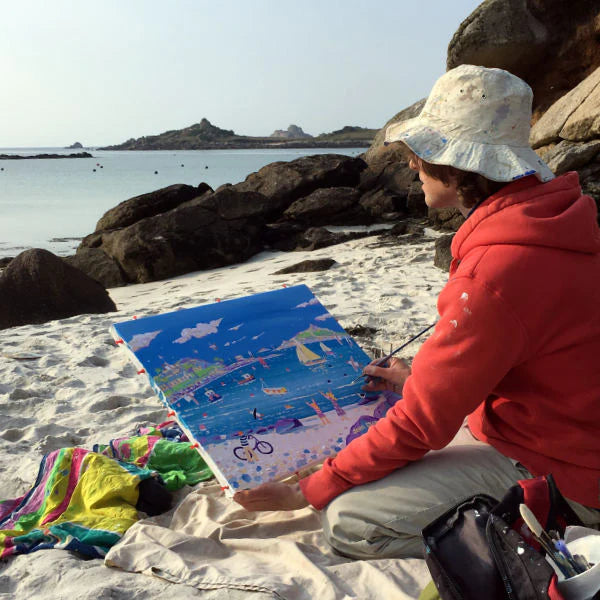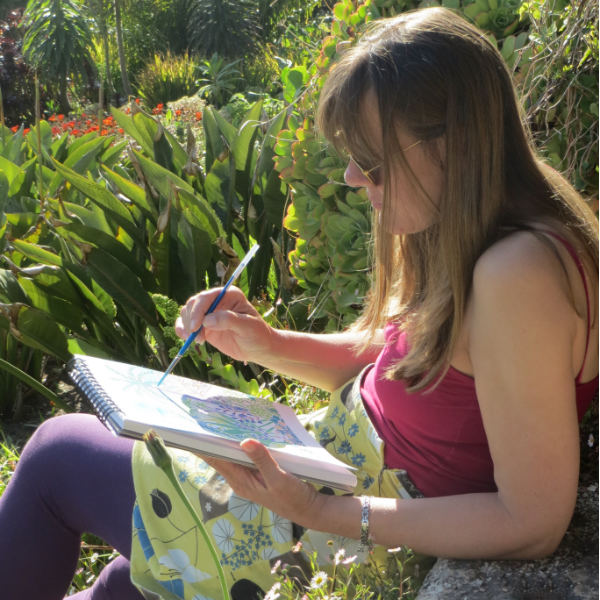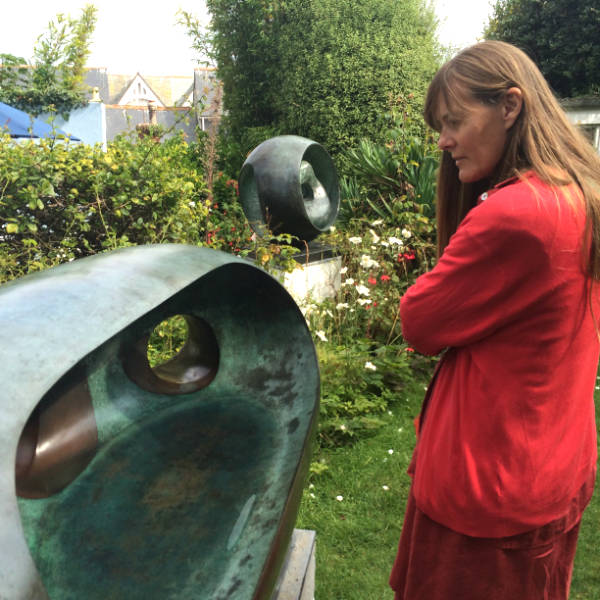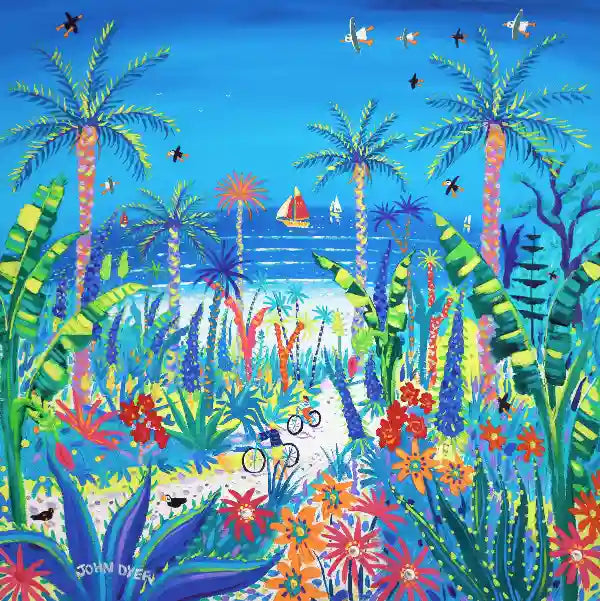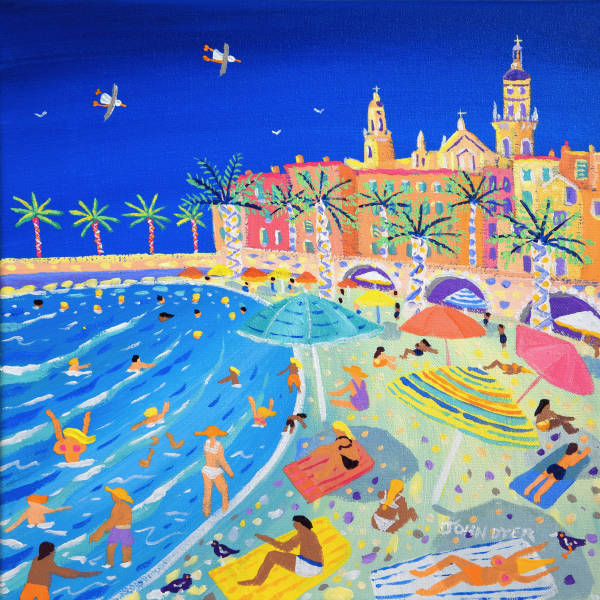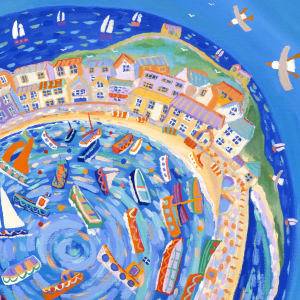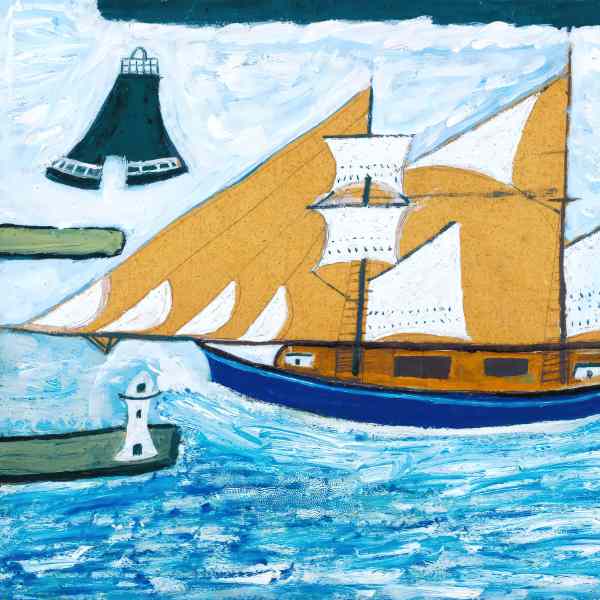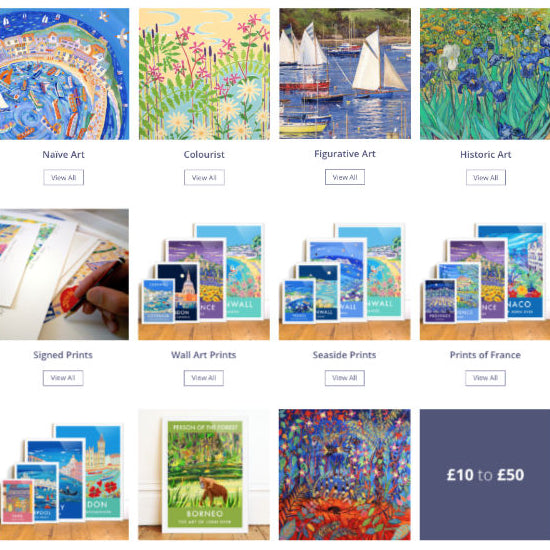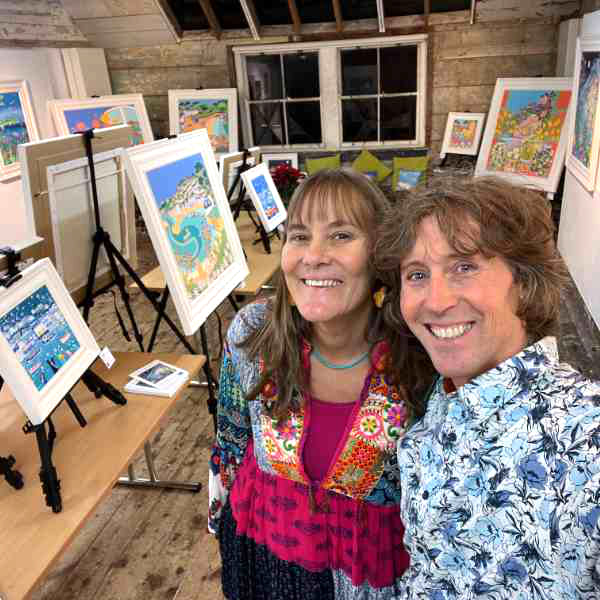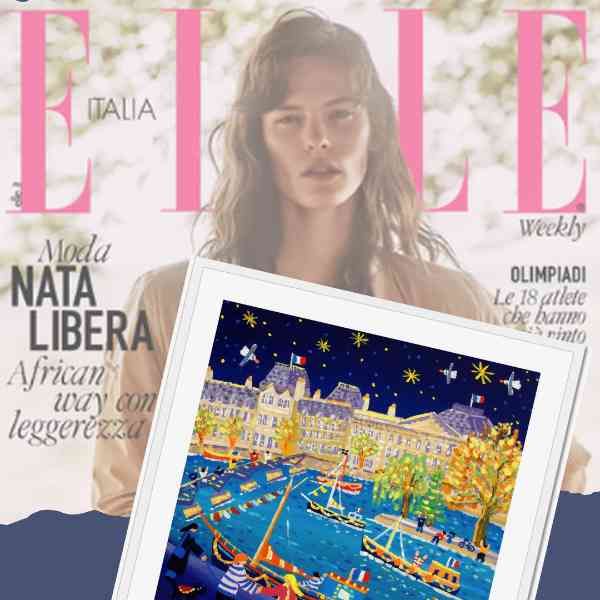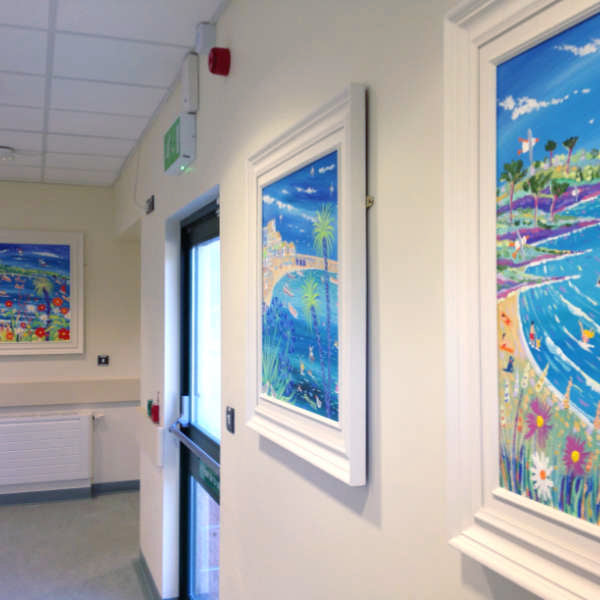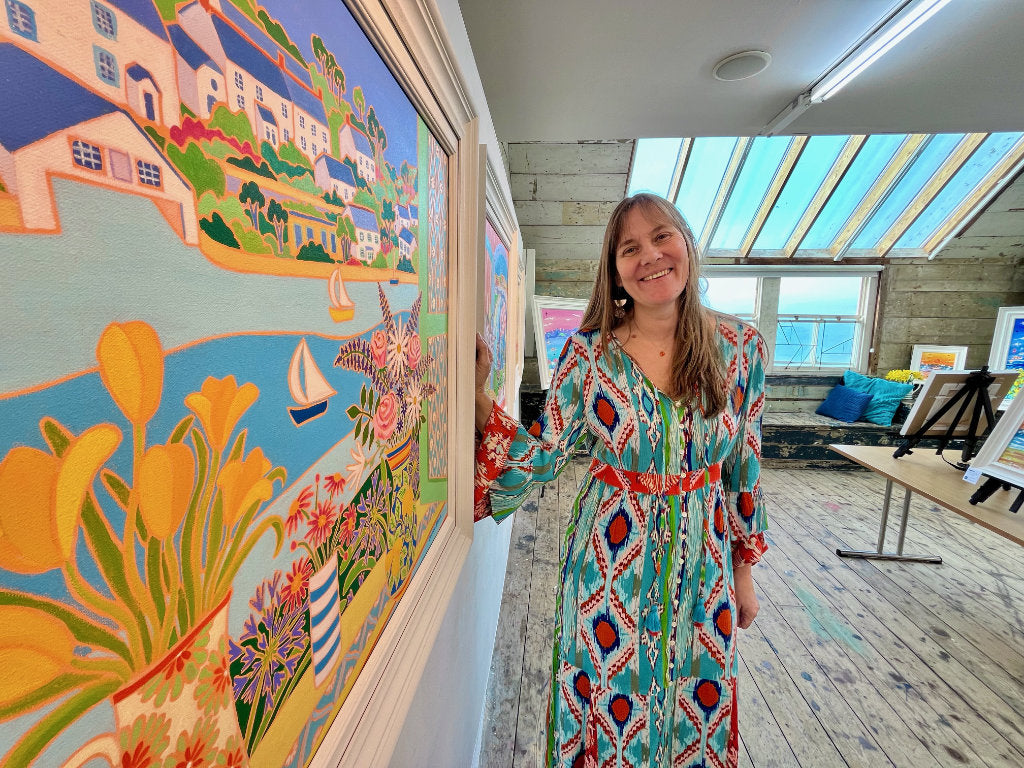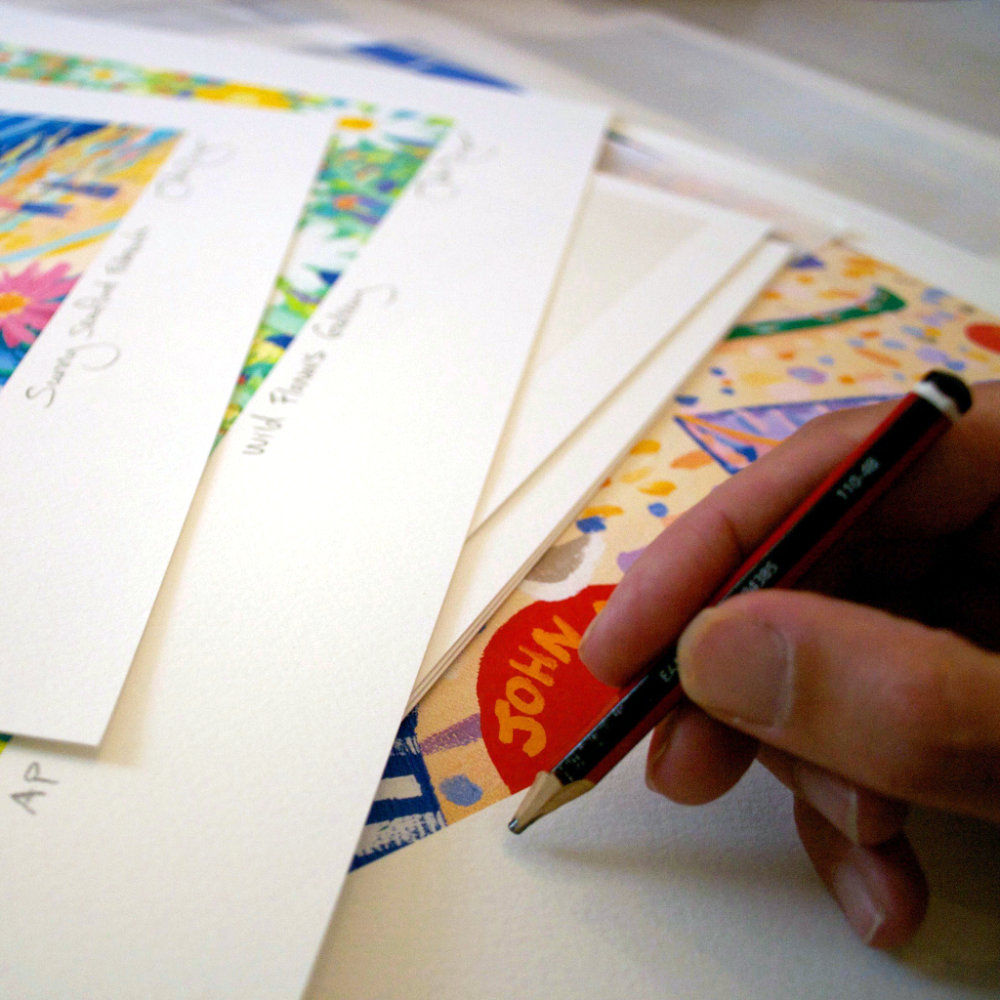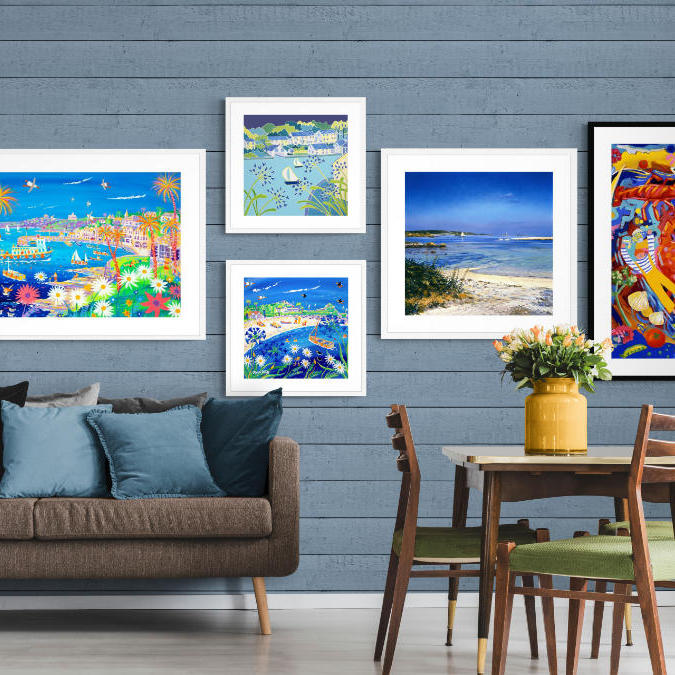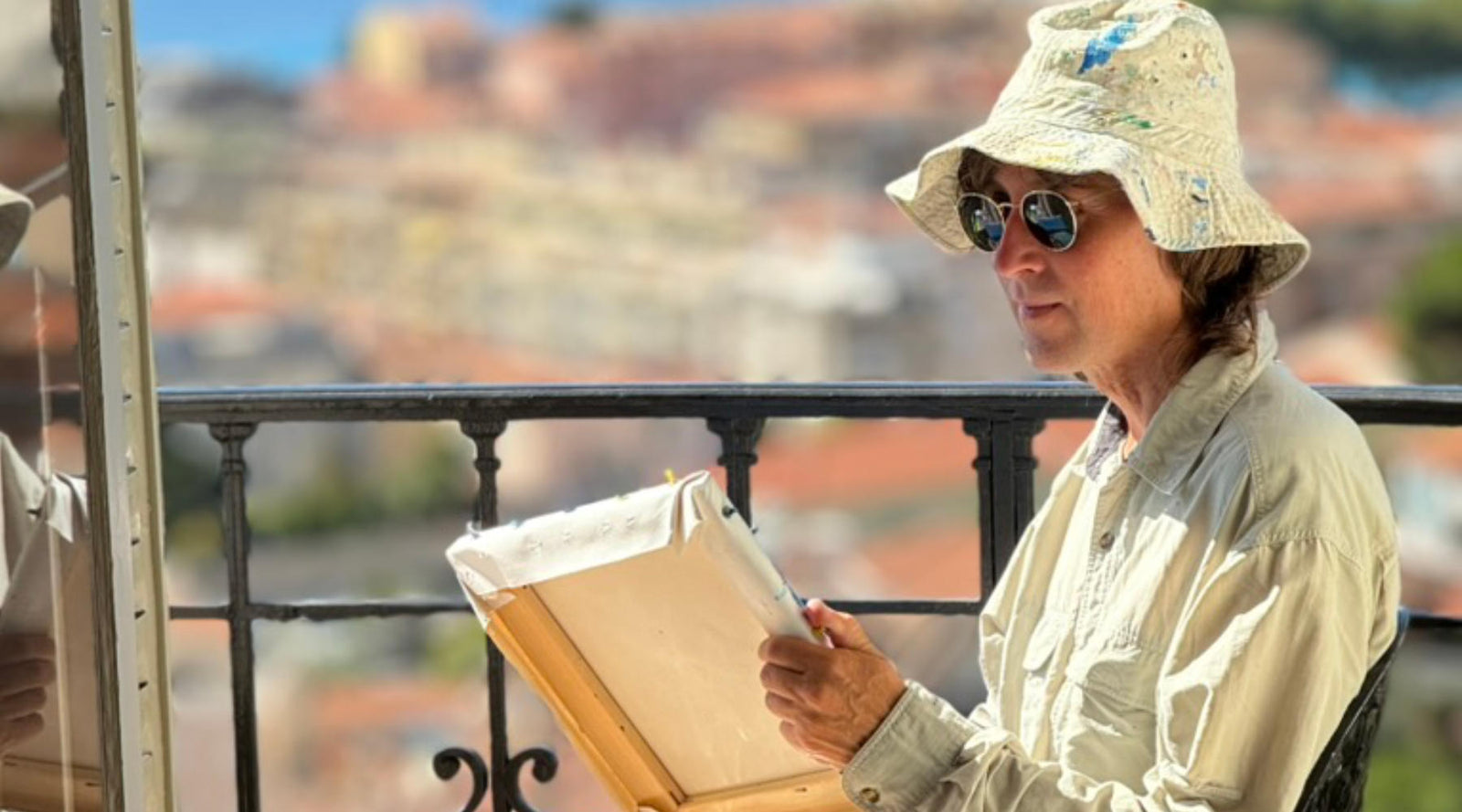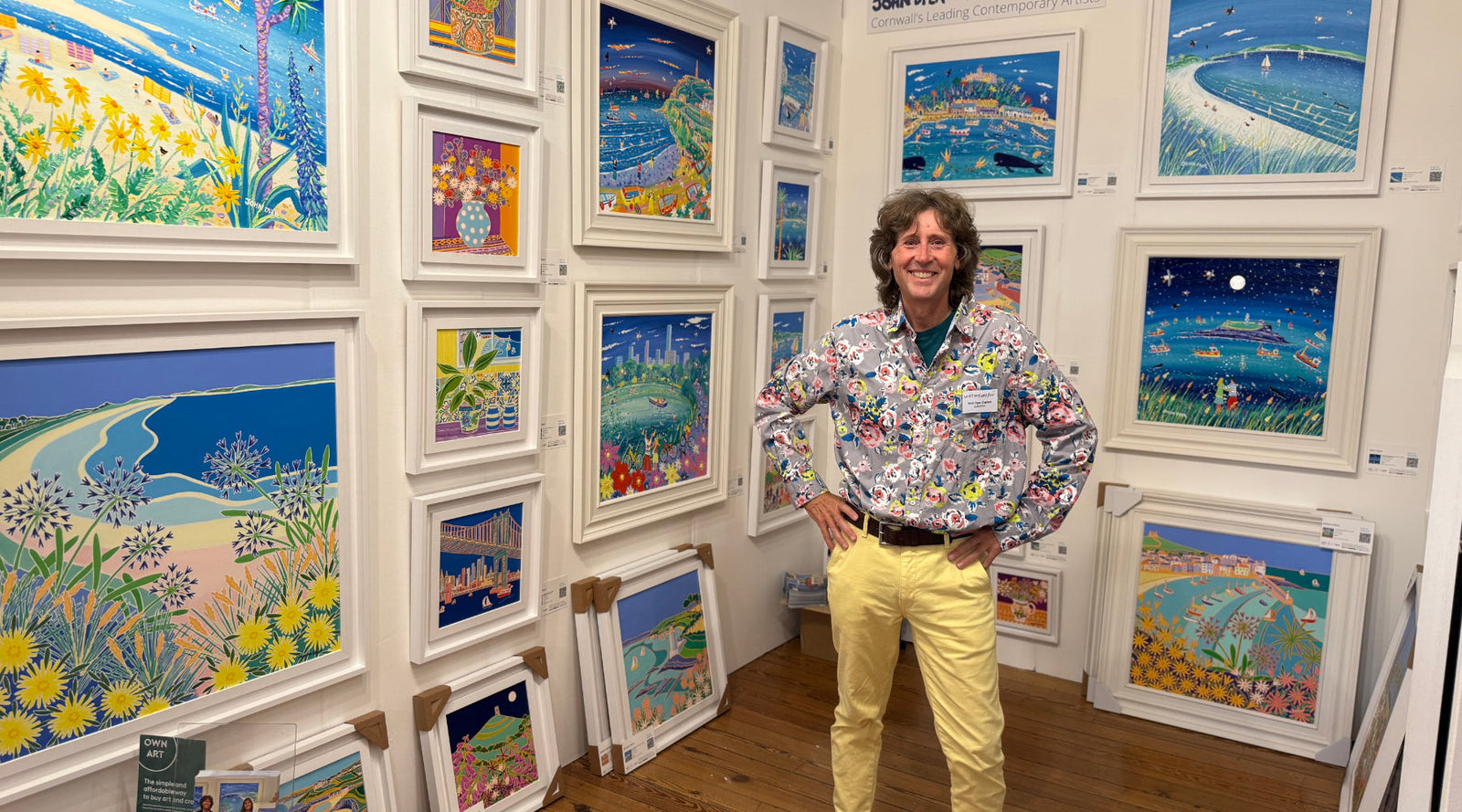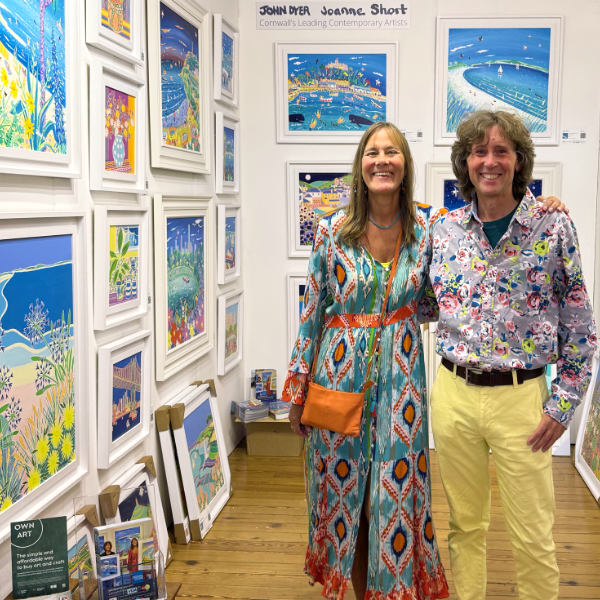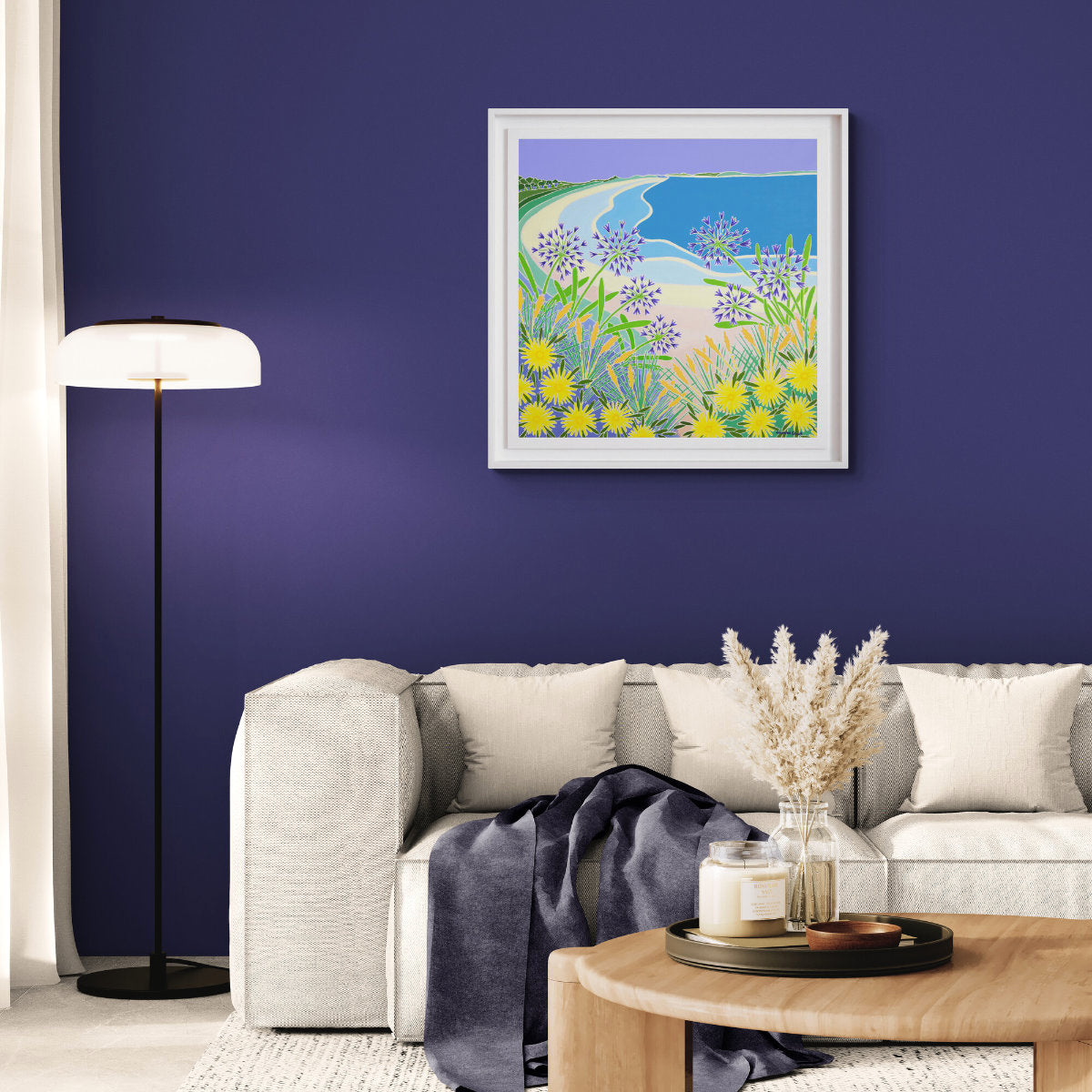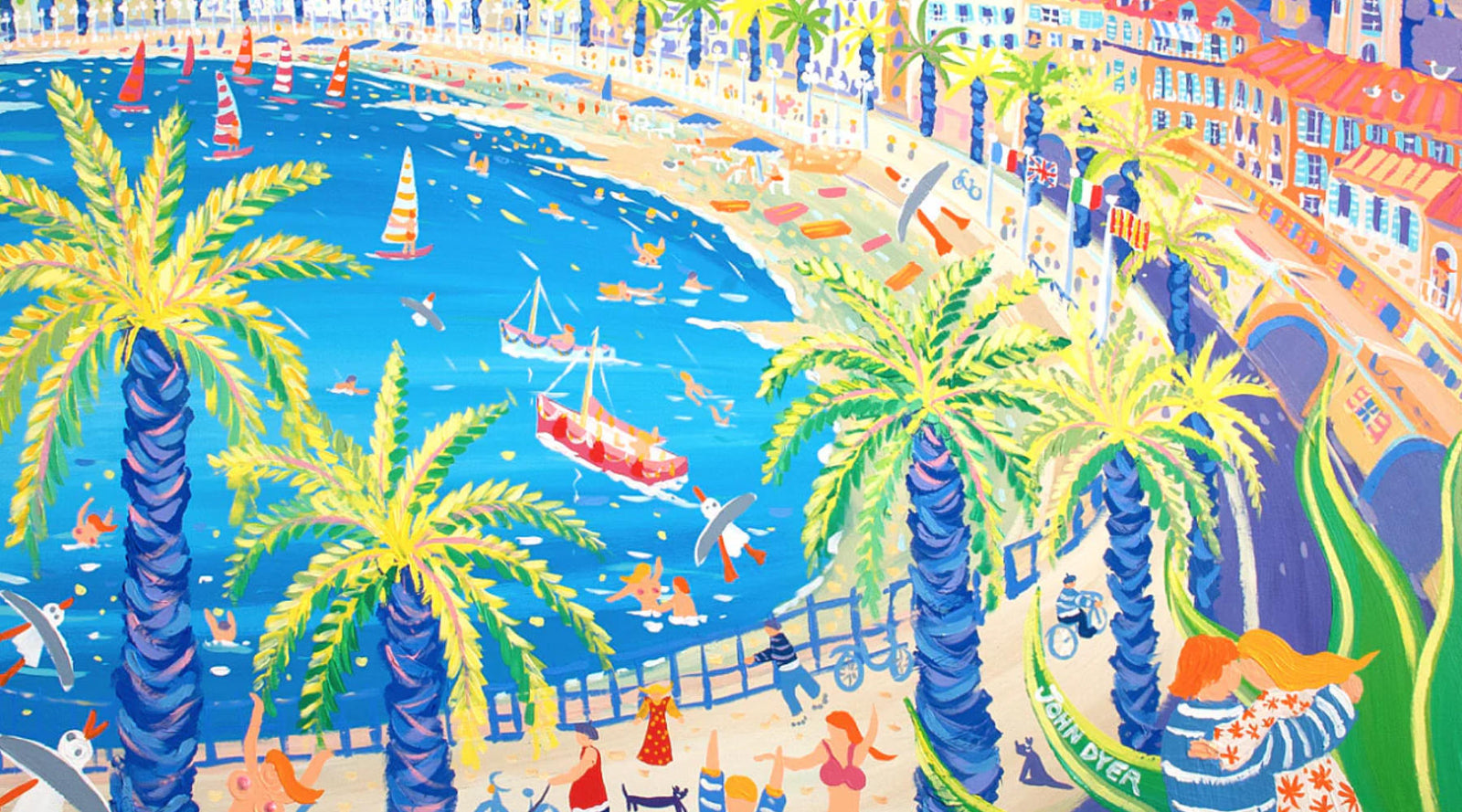
Above: Detail of 'French Kiss, Nice' by British artist John Dyer captures the ocean off the coast of Nice on the Côte d'Azur in France perfectly. Available as a signed limited edition fine-art print
From crashing waves to calm horizons, the sea has long stirred the imagination of artists. Its power, beauty, and ever-changing moods have inspired some of the most iconic works in art history. In this article, we examine how renowned artists such as Leonardo da Vinci, Hokusai, and Claude Monet depicted the ocean in their works. Leonardo da Vinci even created a bird's-eye view of the coastline in 1515, demonstrating an aerial perspective of the Earth's geography.
The ocean covers almost three-quarters of the Earth's surface, making it one of the most dominant features of our planet. Throughout history, artists have sought to capture this vastness, often depicting the globe or using aerial perspectives to show the expanse of the sea.
We also look at how celebrated Cornish artists John Dyer, Joanne Short, and Ted Dyer have captured the unique character of the Cornish coast. Their paintings are filled with colour and a strong sense of place, offering a contemporary response to the same timeless subject.
Together, these artists demonstrate how the sea has continued to move and inspire across centuries and cultures.
Key Takeaways
-
Seascape masterpieces by renowned artists like Leonardo da Vinci, Hokusai, and Monet showcase innovative techniques and evoke powerful emotions, marking significant contributions to art history.
-
Contemporary artists from Cornwall, including John Dyer and Joanne Short, continue to celebrate and explore the beauty of the sea in their original paintings, fostering a connection between art, nature, and environmental awareness.
-
Seascapes have a lasting spiritual and emotional impact, offering viewers tranquillity and reflection, while inspiring modern art movements with their representation of nature’s beauty.
Introduction to Oceanic Art
Oceanic art, often celebrated through seascape paintings, has captivated the imagination of many artists across centuries. The seacoast, with its ever-shifting moods and breathtaking vistas, stands as one of the most powerful muses in the natural world. Artists are drawn to the ocean’s ability to embody both calm waters and wild, untamed energy—qualities that reflect the duality of life itself. From the gentle lapping of waves on a tranquil shore to the dramatic surge of a stormy sea, the ocean offers an endless palette of inspiration. Caspar David Friedrich's painting "The Monk by the Sea" reflects a stark view of sea and sky, emphasising the insignificance of man against nature.
The beauty of the coast is not just in its scenery, but in the life it sustains. Birds soar above the surf, marine mammals break the surface, and the interplay of light and colour transforms the sea from dawn’s soft glow to the fiery hues of sunset. For many artists, the ocean is a sanctuary—a place where the mind finds calm and the spirit is renewed. This connection to the world’s vast waters is evident in countless paintings, where the shore becomes a stage for exploring themes of hope, reflection, and the enduring power of nature.
Throughout art history, from Leonardo da Vinci’s innovative perspectives to Claude Monet’s luminous impressions, the sea has been a constant source of creativity. Seascape paintings invite viewers to experience the world’s beauty, reminding us of the profound relationship between art, the coast, and the natural world.
Leonardo da Vinci's Bird's Eye View of the Sea Coast

Above: Leonardo da Vinci’s “Bird’s Eye View of the Sea Coast” c.1515 - ink on paper. 27.2 x 40 cm
Leonardo da Vinci’s “Bird’s Eye View of the Sea Coast” is a testament to his innovative approach to perspective and his deep understanding of coastal geography. Created around 1515, this ink-on-paper masterpiece measures approximately 27.2 by 40 centimetres and blends elements of map, relief, and imaginative vision. The painting highlights Leonardo’s skill in portraying the interaction between land and sea with remarkable precision, employing texture and shading contrasts to create depth and dimensionality.
An aerial perspective reveals the ocean meeting the land in curving bays, resembling a fitted carpet of blue. Leonardo’s use of hues brings out features of the coastal landscape, blending realism with imagination. This work reflects Leonardo’s technical prowess and innovative vision, marking it as a cornerstone in the history of seascape painting, with every detail carefully considered.
The Great Wave off Kanagawa by Katsushika Hokusai
Above: 'The Great Wave off Kanagawa' by Katsushika Hokusai. Framed Open Edition Fine Art Print. Historic Art
Katsushika Hokusai’s “The Great Wave off Kanagawa” is one of the most iconic seascape paintings in art history. This woodblock print, created in 1831, has become a symbol of Japanese art, resonating profoundly in both Eastern and Western artistic circles. The composition dramatically contrasts the immense wave with the small boats and distant mountains, evoking a sense of awe and vulnerability. Hokusai's "The Great Wave off Kanagawa" significantly influenced Western art and is part of his series "Thirty-Six Views of Mount Fuji."
Hokusai’s double-printing process and colour technique, blending Prussian blue with traditional indigo, produce a visual dynamism that is striking and mesmerising. This masterpiece illustrates the power and beauty of the ocean, capturing the viewer’s imagination and solidifying its place as a timeless work of art.
Capturing Chaos: Rembrandt's The Storm on the Sea of Galilee

Above: Rembrandt’s painting “The Storm on the Sea of Galilee,” created in 1633
Rembrandt’s “The Storm on the Sea of Galilee,” created in 1633, is his only known seascape painting. This dramatic artwork portrays Jesus calming a storm, aligning with biblical accounts from the Gospels of Mark, Luke, and Matthew. Rembrandt’s unique approach includes a self-portrait among the disciples, creating a personal connection to the narrative.
The painting is characterised by dramatic contrasts between light and shadow, a technique known as tenebrism, which enhances the emotional depth of the scene. Measuring approximately 160 cm by 128 cm, this large-scale work was stolen in 1990 during the largest art heist in U.S. history, and its whereabouts remain unknown.
Nonetheless, its impact and significance in seascape painting endure.
Winslow Homer's Wild Seas

Above: Winslow Homer's painting 'Fog Warning' (1885)
Winslow Homer is renowned for his powerful depictions of the ocean’s wild and volatile nature. His seascapes often emphasise fishermen’s struggle against the elements, portraying their perilous livelihoods with vivid realism. In “The Fog Warning,” Homer illustrates a lone fisherman confronting encroaching fog while attempting to return after a successful catch, capturing the perilous conditions at sea. The painting highlights the fisherman’s challenging journey, marked by both emotional and physical struggles as he navigates nature’s obstacles and makes critical decisions in the face of danger.

Above: Winslow Homer's painting 'The Gulf Stream' (1899)
Another notable work, “The Gulf Stream,” features a man in a ship amidst turbulent waters and sharks, representing the inherent dangers that fishermen face. Homer’s works convey the raw power and mystery of the ocean, making them some of the most compelling pieces in coastal art, particularly in their depiction of fish.
Monet's Impressions of the Sea
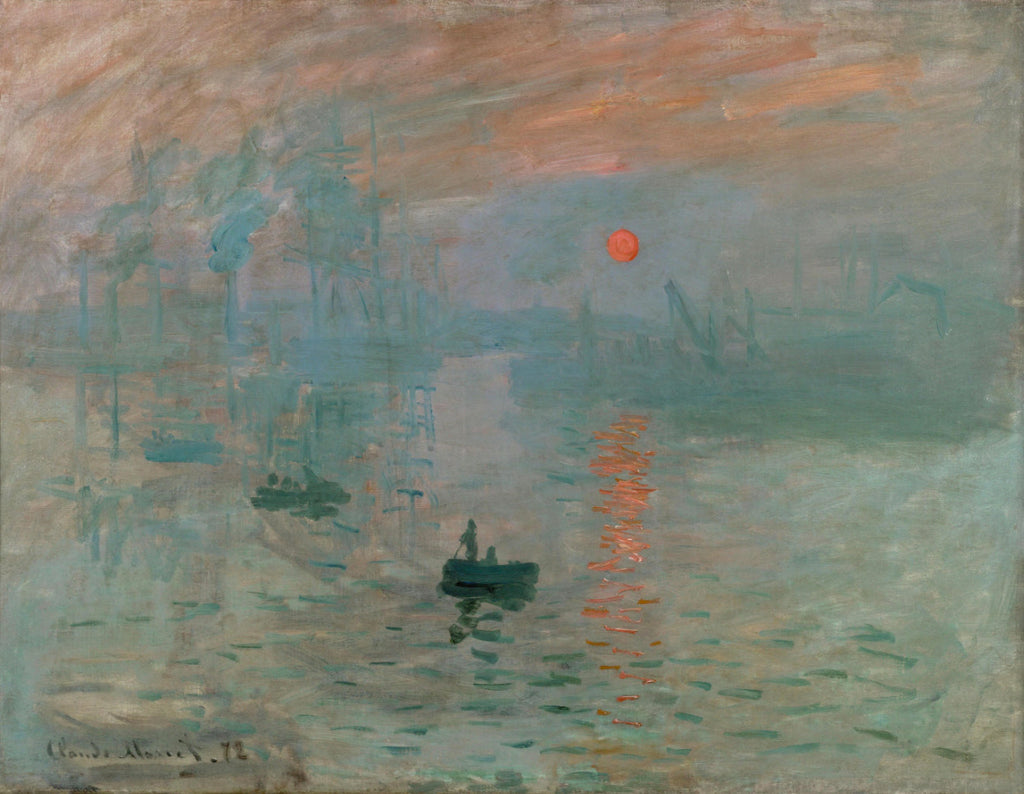
Above: 'Impression, Sunrise' by Claude Monet
Claude Monet’s contributions to seascape painting are integral to the Impressionist movement, emphasising light and atmosphere. His iconic work “Impression, Sunrise” first showcased the innovative techniques of Impressionism, focusing on the transient qualities of light and the depiction of water.
Above: 'Coucher De Soleil À Pourville, Pleine Mer' by Claude Monet. Open Edition Fine Art Print. Historic Art Framed & Mounted Print
Monet’s seascapes are celebrated for capturing the sea’s ever-changing moods and for the remarkable range of tones, colours, and emotions present in his depictions, making them timeless pieces of art under the sun. Claude Monet's "Impression, Sunrise" played a significant role in the naming of the Impressionist movement and depicts the port of Le Havre at sunrise.

Above: 'La Pointe de la Hève at Low Tide' by Claude Monet
Another notable seascape, “La Pointe de la Hève at Low Tide”, reflects a transitional phase in Monet’s style, with a focus on the interplay of light and the depiction of water. These works highlight Monet’s mastery in capturing the serene beauty and dynamic nature of the ocean, solidifying his place as a great seascape artist.
Ivan Aivazovsky's Mastery of Light and Colour

Above: Ivan Aivazovsky's painting 'The Ninth Wave'
Ivan Aivazovsky is renowned for his exceptional ability to capture the interplay of light and colour in his seascape paintings. His masterpiece “The Ninth Wave” symbolises the struggle between humanity and nature, illustrating the dramatic power of the sea through vivid colours and intense light contrasts. Aivazovsky often observed natural phenomena extensively, sketching minimal outlines before creating detailed studio paintings. Ivan Aivazovsky is renowned for his dynamic seascapes and created over 6,000 paintings, including "The Ninth Wave," his most famous work.
Aivazovsky’s artistic style emphasises the emotional resonance in his seascapes, creating depth and a sense of drama that captivates viewers. His works are celebrated for their luminous quality, achieved by layering translucent paint to enhance the depiction of light and shadow. This skill makes Aivazovsky’s seascapes some of the most visually stunning and emotionally powerful in the history of art.
Coastal Beauty in Dufy's Baie des Anges, Nice
Above: Raoul Dufy’s “Baie des Anges, Nice,” painted in 1927
Raoul Dufy’s “Baie des Anges, Nice,” painted in 1927, is a vibrant portrayal of the Mediterranean coast. Nice, a lively coastal city, provides a unique urban backdrop that deeply influences Dufy's work. The city's energetic atmosphere and its relationship with the sea are reflected in his depiction, blending urban vibrancy with the natural beauty of the Riviera. Associated with the Fauvism movement, Dufy’s work emphasises vivid colours and bold brushwork, creating an illusion of space that captures the lively atmosphere of the Riviera. His use of colour and perspective highlights the beauty and warmth of the Mediterranean, making his seascapes visually captivating.
Dufy’s works often depict the deep, intense blue of the Mediterranean Sea, enhancing the visual experience with a counterintuitive hot blue. The distinct shape of La Jetée-Promenade in his work emphasises the warm blues of the sea and sky, creating a scene that is both lively and serene, filled with vibrant colour.
Dufy’s seascapes celebrate coastal beauty, encapsulating the essence of the seaside with his unique style.
Seascape Painting Techniques

Above: Cornish artist John Dyer layers on rich blues as he starts to develop the sea in his paintings
Capturing the essence of the ocean in seascape painting requires a unique blend of observation, imagination, and technical skill. Many artists begin by studying the movement of waves, the shifting patterns of light on water, and the subtle colour changes that occur throughout the day. The use of colour is significant—shades of Prussian blue, turquoise, and deep indigo are often layered to evoke the depth and mystery of the sea, while lighter tones reflect the sparkle of sunlight on calm waters. Artists find endless inspiration in the ocean's changing colours, sounds, and moods.
Texture plays a vital role in bringing seascapes to life. Artists may use thick, expressive brushstrokes to depict crashing waves or smooth, blended techniques to create the illusion of glassy, tranquil surfaces. The interplay between sky and sea is carefully balanced, with clouds, sun, and horizon lines providing a sense of scale and atmosphere. Reflections on the water’s surface add depth and realism, while the foreground might feature rocks, sand, or boats to anchor the scene.
Above: Cornish artist Ted Dyer at work on a painting of the sea and a view to Godrevy lighthouse in Cornwall
Composition is another key element—artists often use the curve of the coastline, the placement of ships, or the sweep of a wave to guide the viewer’s eye through the painting. Attention to detail, such as the glint of light on wet sand or the delicate foam of a breaking wave, enhances the sense of immersion. Whether painting from life on the beach or from memory in the studio, artists strive to capture not only the appearance, but also the essence of the sea—its energy, its calm, and its timeless beauty.
Through these techniques, seascape paintings become more than just pictures; they are windows into the world’s oceans, inviting us to experience the wonder and majesty of the coast from the comfort of our own homes.
Contemporary Seascape Artists from Cornwall
Above: Cornish artist John Dyer pictured in the Porthmeor studios in St Ives with a collection of his seascape-inspired paintings
Cornwall is home to some of Britain’s most acclaimed contemporary seascape artists, including John Dyer, Joanne Short, and Ted Dyer. These artists capture Cornwall’s spectacular coastline, each bringing a unique perspective and style.
Their seascapes often depict elements such as sailing boats, lighthouses, and the stunning landscape of Cornwall, making them a significant contribution to contemporary coastal art images.
John Dyer's Vibrant Coastal Scenes
Above: 'Frolicking in the Harbour, St Michael's Mount', 18x24 inches acrylic on canvas. Coastal Painting of Cornwall by Cornish Artist John Dyer
John Dyer is celebrated as Cornwall’s best-known contemporary artist, renowned for his vibrant depictions of the region’s landscapes and his commitment to environmental themes. As an official Artist for the Earth with EarthDay.org and the artist in residence for the Eden Project, Dyer’s work often reflects his dedication to celebrating nature and addressing ecological issues. His colourful and dynamic seascapes capture the essence of the coast, bringing sea and shore scenes to life with his unique style.
Dyer’s work is showcased in the John Dyer Gallery, which features a collection dedicated to his art, including prints of Cornwall and seascapes. His paintings are visually stunning and remind us of the importance of preserving our natural world, merging aesthetics with advocacy.
Joanne Short's Exquisite Colourist Oils
Above: 'Looking Through the Agapanthus, Pentle Bay, Tresco', 30x30 inches oil on canvas. Original Painting by Cornish Artist Joanne Short
Joanne Short is one of Cornwall’s best-known contemporary artists, recognised for her exquisite colourist oil paintings that capture the essence of Cornwall’s beauty. An elected member of the Newlyn Society of Artists, Short’s work is celebrated for its vibrant colours and light, reflecting her deep connection to the coastal environment. Her paintings often depict Cornwall’s stunning landscapes and seascapes, bringing the region’s natural beauty to life with her distinctive style.
In addition to her oil paintings, Short has diversified her artistic output to include ceramics and limited edition prints, expanding her influence beyond traditional painting. The John Dyer Gallery proudly represents Joanne Short’s paintings, showcasing her contributions to contemporary Cornish art.
Ted Dyer's Timeless Masterpieces
Above: 'Sailing out from Falmouth (Funchal Tall Ships Regatta)', 18x24 inches Original Art Oil on Canvas. Seascape Painting of Cornwall by Artist Ted Dyer.
Ted Dyer, born in 1940, is recognised as one of Cornwall’s most accomplished and collected artists. With a painting career spanning over 60 years, Dyer is known for his impressionistic style and his ability to evoke a sense of nostalgia in his landscapes. His work is renowned for its exceptional quality, depth, and mastery of paint, making each piece a modern masterpiece and a lasting heirloom for future generations.
Dyer’s paintings are prominently featured in the John Dyer Gallery, which claims to be the exclusive gallery for his work. His impressionist landscapes capture Cornwall’s coastal beauty, making him one of the most widely collected artists in the region.
Dyer’s amazing, timeless masterpieces continue to inspire and captivate art lovers, solidifying his legacy in the world of seascape painting.
The Influence of Seascapes in Modern Art
Seascapes have significantly shaped modern art, particularly influencing Impressionism and Abstract Expressionism. The fluidity and movement captured in seascapes have inspired techniques in Abstract Expressionism, emphasising spontaneity and emotional depth. Artists like Claude Monet, who was influenced by seascape painter Eugene Boudin, have contributed to the evolution of seascape painting by focusing on light and atmosphere.
Above: 'La Sortie des Barques à Trouville' by Eugène Boudin. Framed Open Edition Fine Art Print. Historic Art
The impact of seascapes on art is evident in the works of contemporary artists who continue to explore the relationship between nature and human experience. Cornwall, with its spectacular coastline, remains an ideal location for seascape artists, contributing to the rich tradition of coastal art.
Some modern artists create artworks from plastic debris collected on beaches or address the issue of plastic pollution in the ocean, reflecting contemporary environmental concerns.
Seascape paintings capture the ocean’s transient qualities, and, in the past, pictures of waves continue to inspire modern art movements.
The Spiritual and Emotional Impact of Seascapes

Above: Ted Dyer Framed Open Edition Cornish Fine Art Beach Print. 'White Sands Pentle Bay, Tresco'. Cornwall Art Gallery
Seascapes have a profound spiritual and emotional impact on viewers, evoking feelings of connection between the mind, body, and soul. The representation of water in these paintings can provide a sense of tranquillity and meditation, significantly influencing the viewer’s emotional response. Colours like blue and purple are often associated with peace and reflection, adding to the calming effect of calm waters. Seascape paintings can also evoke the feeling of walking along the shore, enhancing the sense of calm and deepening the viewer's connection to nature. Seascape paintings can evoke a range of emotions from awe to despair.
Many modern artists draw parallels between the vastness of the ocean in seascapes and the exploration of the subconscious in their works. Viewing seascape paintings can uplift individuals experiencing difficult times, offering a sense of companionship and hope, and allowing them to find calm rest against a background of inspiration. Many artists realise inspiration in this connection.
The exploration of nature in seascapes continues to inspire artists, providing a vital source of inspiration for expressing personal experiences and emotions.
Summary
Seascape paintings have captivated audiences for centuries, offering a glimpse into the ever-changing beauty and power of the ocean. From Leonardo da Vinci’s innovative perspectives to the vibrant works of contemporary artists from Cornwall, these masterpieces continue to inspire and move us. The exploration of light, colour, and emotion in seascapes has significantly influenced art movements and continues to provide spiritual and emotional solace to viewers. As we reflect on these incredible works, we are reminded of the timeless allure of the sea and its enduring impact on art and humanity.
Frequently Asked Questions
How do seascape artists typically depict the sea?
Seascape artists beautifully capture the sea's moods and textures, bringing its dynamic beauty to life with realism. Their work invites you to experience the ocean's allure in every brushstroke!
Who are three of Cornwall's most acclaimed contemporary artists?
Three of Cornwall's most acclaimed contemporary artists are Ted Dyer, Joanne Short, and John Dyer, each bringing their unique vision and creativity to the vibrant art scene. You'll find their inspiring works truly captivating!
What types of paintings are available that feature Cornwall?
You can find beautiful original oil and acrylic paintings that showcase the stunning landscapes and seascapes of Cornwall. These artworks capture the vibrant essence of the region, making them an excellent addition to any collection!
Where do the artists work from?
Artists often work from their studios in Falmouth, drawing inspiration from the beautiful harbours and villages in Cornwall. This vibrant setting fuels their creativity!
What is the relationship between the three artists at JohnDyerGallery.com?
They're all related, creating an incredible familial bond through their artistry!




